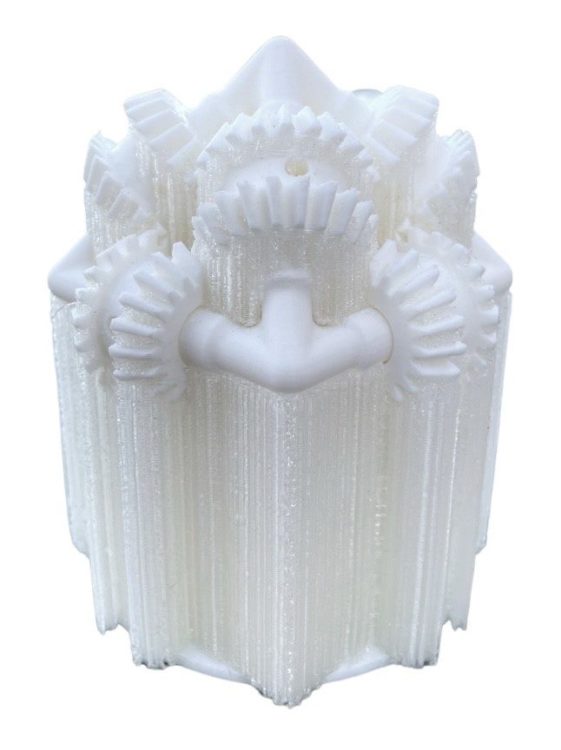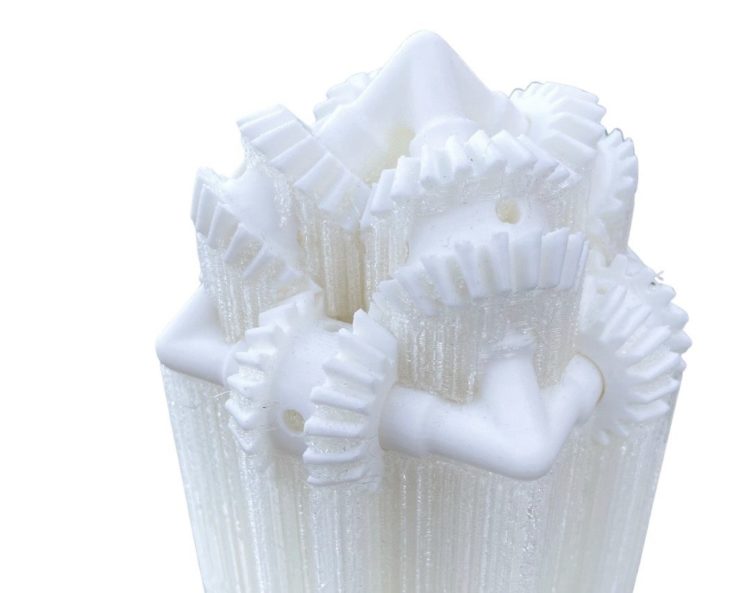What Are Dual Extruder 3D Printers and IDEX 3D Printers?
Dual extruder 3D printers perform advanced functions to accommodate a wide variety of 3D printing projects, making a 3D printer an important asset. Dual extruder 3D printers have many applications and can be incorporated into business operations to improve prototyping, production, and manufacturing processes. A comprehensive understanding of a dual extruder 3D printer’s mechanical setup and functionality is crucial for businesses to decide whether they need a dual extruder 3D printer, and if so, what type of dual extruder 3D printer will be the right one for their needs.
What is an Extruder? What is the Function of the Extruder in a 3D Printer?
FFF 3D printing is the process of melting and extruding a 3D printing material, also known as filament, then building up thin layers of the melted material to create a physical object. The system of parts that operate together to melt then release the melted filament to build up the layers of a 3D printed part is generally known as the extruder or extruder system of an FFF 3D printer. The two main parts of an extruder system are the cold end and the hot end.
The 3D printer feeds the spool of 3D printing filament to the cold end. The cold end generally consists of a motor and gear. The motor runs to turn the gear. The gear then grabs and guides the filament strand through a tube that connects to the hot end.
The hot end receives the filament that is passing through the tube from the cold end. It passes the filament into a chamber that is already heated to the melting temperature of the filament. This heated chamber is also known as a heat block. The melted filament is then ejected through nozzles onto the build plate. To learn more about the different types of nozzles available for a 3D printer, click here.
What is a Dual Extruder 3D Printer?
Why Are Dual Extruders Important?
In short, the benefit of having a dual extruder 3D printer is performing dual extrusion 3D printing. Dual extrusion printing means both extruders will be used during the printing process. This capability enables a dual extruder 3D printer to perform more advanced functions and processes to accommodate a wider variety of 3D printing projects than a 3D printer with a single extruder.
Two typical uses of a dual extruder 3D printer are printing are for:
- dual-color model
- dual-material model
A dual-color model is when one model has a 2 different color pattern. The two different colors can show an image or information. An example of a dual-color model is the Raise3D coin, which is printed in the colors red and black. The red and black colors function not only to create the Raise3D logo but also to distinguish the company’s contact information.

Dual Color 3D Printed Raise3D Coin



A dual-material model is when one model uses two different materials, also known as filaments*.
*Not all materials can print with another material. To learn more about which materials can be printed together, please contact Raise3D.
A good example of why being able to print dual-material models is important is in printing a model that needs a support structure. Support structures are usually required for parts that have an overhang or bridge geometry. A support structure will prevent the overhang or bridge geometry from breaking before the filament has a chance to cool off and solidify. Support structures are created in the 3D slicing software with the model and assigned to an extruder and 3D printing material to print this support structure.
A support structure can also be printed with a second extruder and material. This means one extruder and material will be assigned to print the model, while the other extruder and material will be assigned to print the support. This method of printing a support structure is another example of printing a dual-material model.
Side Note: A support structure can also be printed using the same extruder and material as the model part. This means the same material and extruder will print the model and the support structure.

PLA Printed Part After Dissolved PVA Structure
It is important to remember that not all 3D printing materials can be paired together. Therefore, the material of the support structure will depend on what can work with the material that is used for the model.
Two common combinations of materials used for printing a model with a support structure are:
- PLA filament for the model with PVA as a support material
- ABS filament for the model with HIPS as a support material
However, removing the support without causing damage to the model is an important concern to keep in mind. PVA filament is a popular and practical material for support structures when applicable.

Dual Material PLA and PVA 3D Printed Part
PVA is water-soluble, meaning it dissolves in water. Therefore, when a model with a PVA support structure is submerged in a water bath, the support will eventually dissolve, leaving behind the model. In general, using soluble supports will make the process of removing the support less painful and less of a hassle. However, soluble supports are invaluable for models whose design makes it difficult or impossible to remove the support structure if the support’s material is not dissolvable. Below is an example of a model that would be difficult to remove the support structure if the material for the structure was not soluble.


Close Ups of 3D Printed Parts
Another common example where dual-material printing is necessary is in producing 3D printed parts with texture. Dual extrusion can achieve this result by printing with two materials: for example, one hard material and one flexible material. The hard material extrudes from one extruder while the flexible material extrudes from the other extruder. As a result, the printed part will be partially soft and flexible, and partially rigid.
There are times when a part can be dual material, with each material being a different color, making it dual color as well. An example of a dual material and dual color model is this Rigid Heel Insole. It is printed in the materials TPU and PLA, in the colors red and white.

Dual Material Dual Color 3D Printed TPU and PLA Insole


A dual extruder 3D printer’s capability to print models in two colors or two materials gives its users more freedom when designing the models and more applications.
What are the Types of Dual Extruder 3D Printers?
A dual extruder 3D printer will feature one of two types of dual extruders, dependent or independent extruders, also known as IDEX. For this guide, we will refer to non-IDEX extruders as dual extruders and non-IDEX 3D printers as dual extruder 3D printers.
People mainly categorize the dual extruder 3D printer by how the dual extruders are set up.
- One type is when both extruders are attached and moving together when printing, which is called dependent dual extruders. However, dependent dual extruders are also known as dual extruders.
- The other type is when both extruders are detached and able to move individually along the axis when printing. This type of extruders is known as independent extruders or IDEX.
For this guide, we will refer to non-IDEX extruders as dual extruders.
Since dual extruders are attached and move together during printing (also known as contact design), there is a risk of the nozzle interfering with the print job during the printing process. To minimize this risk, the dual extruders must have electronic lifting technology. A lifting nozzle technology leads to a higher quality print job because it will lift a nozzle up to minimize the risk of the nozzle interfering with the print job. The Pro2 and Pro2 Plus from Raise3D are examples of dependent dual extruder 3D printers with a 1.5 mm lifting nozzle technology.

Pro2 Dual Extruder 3D Printer
Independent dual extruders are detached and can move individually along the axis when printing, giving a dual extruder 3D printer with IDEX added capabilities.
It is important to note that while both types of extruders produce high-quality print jobs and can perform advanced processes, a dual extruder 3D printer with IDEX can perform even more specialized functions.
What is an IDEX 3D Printer?
An IDEX 3D printer is a 3D printer with independent dual extruders. An IDEX 3D printer, such as the E2 from Raise3D, is capable of even more specialized functions such as printing in Duplication Mode and Mirror Mode.

E2 Desktop 3D Printer
Duplication Mode is printing in a synced pattern. Duplication Mode one extruder creates a part, and the second extruder creates an exact copy of that same part. This advanced feature will double production within the same timeframe.
Mirror Mode is when the independent extruders work individually to print a part and an inverse of that part. This means one extruder prints a part while the second extruder simultaneously prints the inverse of that part. This advanced feature will create two 3D printed parts at the same time, increasing production, while shortening a project’s timeline.
When printing in Duplicate or Mirror mode with IDEX, both extruders will move independently along the axis in a synced (duplicate mode) or mirrored (mirror mode) pattern. This also means that even with an IDEX 3D printer, it is not possible to print 2 different models from 2 different extruders at the same time (unless the two models are mirrored).
If the IDEX 3D printer is not printing in Mirror or Duplicate Mode, one of the extruders can remain off to the very of the other side while the other extruder prints. This means an IDEX printer can perform print with one extruder without the risk of damaging the print job with the motionless extruder.
If a dual extruder 3D printer is well designed and manufactured and has the proper software settings it can produce high-quality dual extrusion prints, regardless of whether or not the printer has IDEX. However, IDEX opens up the printer’s functionality beyond producing high-quality dual extrusion prints, to printing in Duplicate mode or Mirror mode increasing the productivity per machine per print round.
Different dual extruder 3D printers can perform dual extrusion printing and more advanced functionalities. This opens up their capabilities making these 3D printers important assets capable of improving operations such as production and manufacturing in a wide range of industries.
























